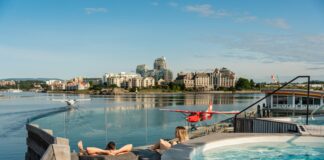Think back to when you were eight years old. What was your walking range unaccompanied by an adult? In the 1920s, it was often nine kilometres. For the next generation, it was less than two kilometres, the next, less than a kilometre, and now, only to the end of our block.
How did North Americans bleed out their ability to take a walk at early ages, and now at all ages? We not only gave up the range of our walking, but our links to nature, our ability to socialize, our choice of ways to go places, and even the number of friends that we have. We have whittled down our health and happiness.
We lost our ability to be physically, emotionally, socially, and mentally healthy. We gave up walking, not because we were lazy, but because we over-designed our neighbourhoods and cities for cars and for speed.
We can reclaim much of this loss by returning to historic patterns and focusing on people. Many communities are taking the right steps, amping up their walkability, and hence their economic life, resiliency and even their sustainability.
Only 20 to 30 per cent of how long and healthy we live is based on our genes. The other 70 to 80 per cent is based on our lifestyles. We have a choice. We can move to a walking oasis by knowing walkability qualities that fit us and make us fitter, or we can help improve the neighbourhoods where we choose to live.
After 40 years of defining and helping 3,800 neighbourhoods build for walkability (many in Canada), I moved to one that is already walkable, Port Townsend in Washington, and now I work to make it more walkable.
I am not alone in choosing walkability for health and personal economics. The U.S.-based National Realtors Association tells us that 79 per cent of home buyers want walkability. The percentage seeking this elixir for health is rising, and fast. In 1970, the term walkability did not exist back when we still had this quality. Since then, we’ve lost many such walkable places, and now we want them back.
Why Walkability?
Walkable communities are healthier and more economical, but they also offer so much more. They are more diverse, resilient, sustainable, friendlier, and greener. These in-demand neighbourhoods draw people from all income brackets, and research shows that people who live in walkable neighbourhoods and communities are healthier and happier by clear margins.
Walkability Leads To Physical, Mental, And Social Wellness
The average resident of walkable neighbourhoods weighs less than someone who lives in sprawling neighbourhoods. Walkability is associated with higher levels of arts organizations, creativity, and civic engagement. Communities with good public transit and walkable access to amenities promote significant added friendship and happiness.
Higher walkability scores are also linked to stronger neighbourhood economic well-being. If you move from a suburban, car-dependent neighbourhood to one that is truly walkable, you can live car-lite, or with no car at all, allowing you to afford a nicer home, a greater social life and naturally walk more. For example, people living in Blue Zone-researched communities live 12 years longer and with greater health.
Walkability Is More Than Walkways
I like to define walkability with the guiding words security, comfort, convenience, efficiency, and welcomeness. When in a place where we do not feel comfortable walking, our Spidey sense alerts us. In such places, traffic speeds and volumes are high, motorists are tuned out and rude, we don’t see a diversity of other people walking, houses and buildings fail to watch over the street. They lack windows, and all homes look the same.
In areas void of people walking, we experience starkness, which can lead to reduced walking. So yes, our walking environment determines not only how much we walk, but the actual uplift and joy we get from our walking experience. If we walk in joyful places we feel better about ourselves.
When we finally get walkability elements back in place, all of them in combination, the word walkability will evaporate from our vocabulary. I look forward to the day when a word I helped popularize in the 1980s disappears from our vocabulary. By working together with purpose and drive, we will reclaim every street and every brook, one step at a time. Take the next step now.
Feature photo by Dan Burden
You may also like: Physical Activity is Medicine

Read This Story in Our 2023 Summer Outdoor & Travel Issue
Featuring Alison Jackson, Canadian cyclist and only North American male or female to win the famed Paris Roubaix. Travel the country’s most stunning hot spots by campervan. Become a better trail running by improving your ascents and descents—plus, train outdoors with Canada’s Top Fitness Trainers. Enjoy plant-based summer recipes and so much more.

















